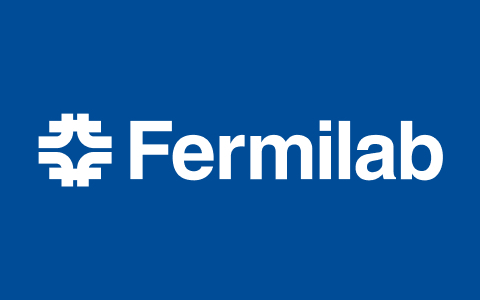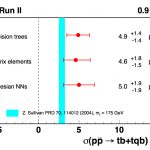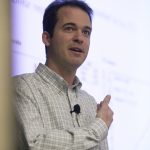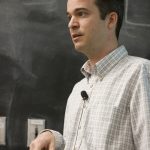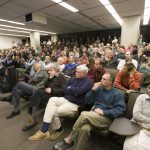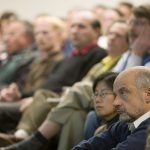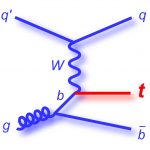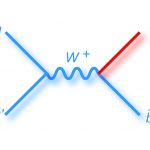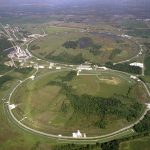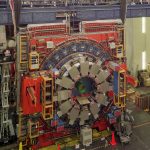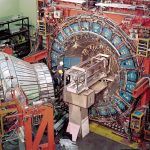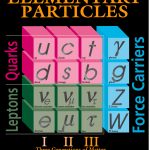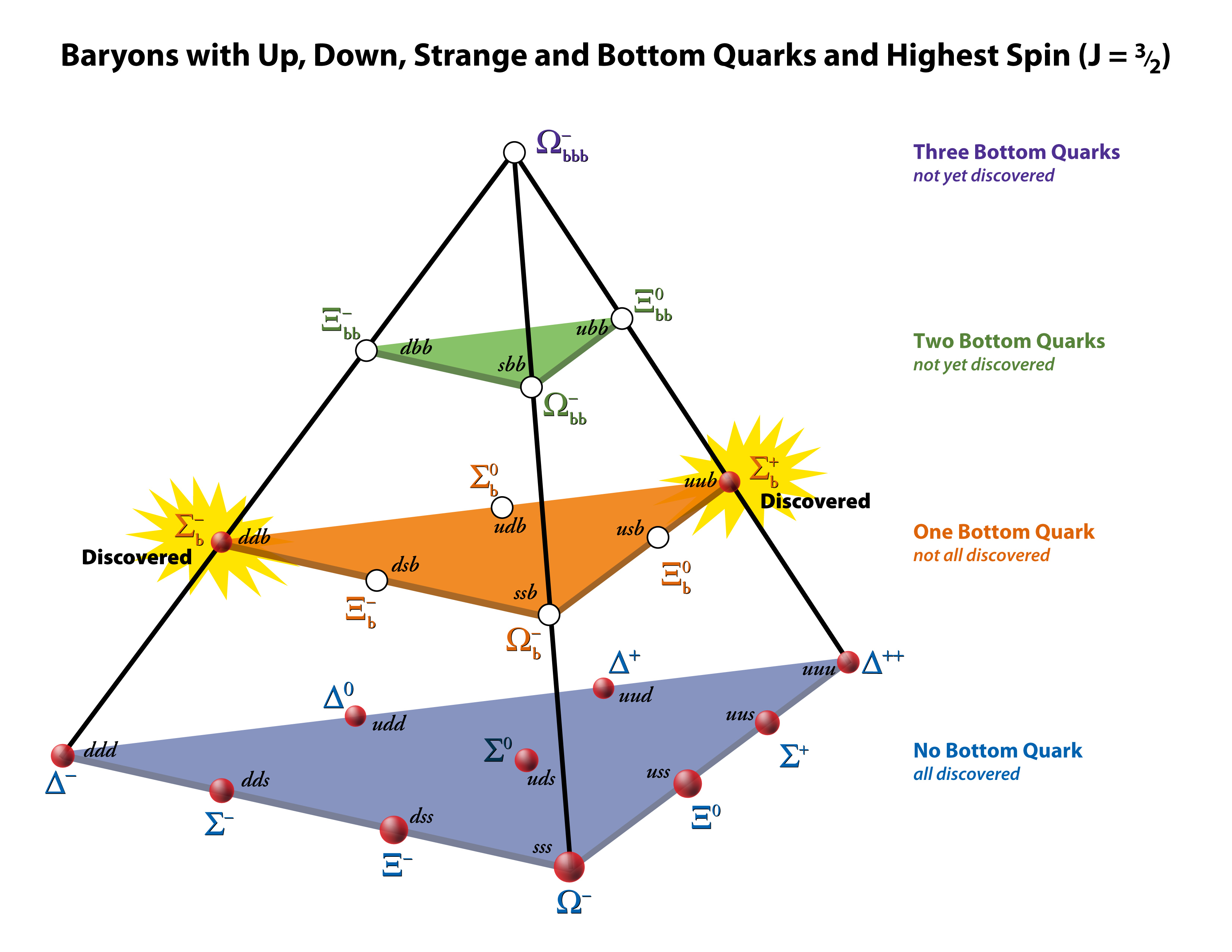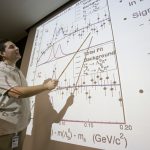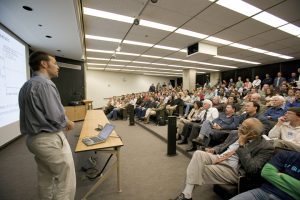Batavia, Ill.–Scientists of the DZero collaboration at the Department of Energy’s Fermi National Accelerator Laboratory announced in a seminar at Fermilab on December 8, 2006 the first evidence of single top quarks produced in a rare subatomic process involving the weak nuclear force. The result is an important test of predictions made by particle theory, such as the number of quarks that exist in nature. In the longer term, the techniques employed in this analysis will allow scientists to search for an even more elusive particle, the Higgs boson.
“I am delighted by the DZero results and what they portend for the future,” said Fermilab Director Pier Oddone.
Starting from a million billion proton-antiproton collisions produced by Fermilab’s Tevatron, the world’s most powerful particle collider, the DZero collaboration used modern sophisticated analysis techniques to search for about 60 collisions, each containing a single top quark. Up to now, scientists had observed the top quark only in subatomic processes involving the strong nuclear force, which produces pairs of top and antitop quarks. Those observations, made by both the DZero and CDF experiments at Fermilab, led to the discovery of the top quark in 1995.
“Observing a few single top quarks in a sea of billions of particle collisions represents an extraordinary technical tour de force,” said Dr. Robin Staffin, Associate Director for High Energy Physics in DOE’s Office of Science. “The power and sophistication of experimental analysis techniques like those developed by the DZero experimenters augur well for exciting discoveries to come.”
Separating a handful of single-top events from two billion events recorded since 2002 allowed the DZero collaboration to determine one of the most important unmeasured parameters of the Standard Model of particles and forces, known as Vtb (pronounced “VTB”). This parameter determines the rate of single-top production: If there are only six quarks, as scientists have observed so far, theory predicts the magnitude of Vtb to be close to one. Departures from this magnitude would be a sign of new physics, indicating the existence of additional quarks or other fundamental particles. The DZero collaboration determined the magnitude of Vtb to lie within the range of .68 to 1.0 with a 95 percent probability, consistent with the Standard Model. Collecting more collision data and further refining the analysis will yield tighter constraints on the value in the upcoming months.
The signature of single-top events is easily mimicked by other subatomic processes that occur at much higher rates. To stand a chance of seeing the single-top signal, physicists at the DZero experiment had to develop sophisticated selection procedures. The first stage selected approximately 1,400 candidate events. Of these candidates, only about 60 single-top events were expected, and experimenters exploited every bit of information to unambiguously establish their presence. DZero scientists used three different techniques to combine some 50 discriminating variables to represent the results. These distributions allowed physicists to recognize the presence of single-top events-much like a mother’s uncanny ability to distinguish between identical twins. The results of the analysis will be submitted this week for publication in Physical Review Letters.
“This analysis is an important milestone in our continuing search for the Higgs boson, the missing keystone in the Standard Model,” said DZero cospokesperson Terry Wyatt, of the University of Manchester, UK. “The discovery of the Higgs boson would help explain why particles have mass. Observing the Higgs requires us to see very low rate signals in the presence of substantial backgrounds. The sophisticated analysis techniques we are honing in our current analyses will be directly applicable to our Higgs searches.”
DZero cospokesperson Dmitri Denisov, of Fermilab congratulated his fellow collaborators.
“This exciting result would not be possible without the tireless efforts of over 600 DZero scientists and the wonderful accelerator that produced all these collisions,” Denisov said. “Bravo to the Tevatron and the people who make the machine work. The search to understand the fundamental forces of nature is mankind’s timeless quest, and it has led us to the discovery of powerful physics laws, new technologies and benefits for society.”
Notes for editors:
DZero is an international experiment conducted by physicists from 90 institutions and 20 countries. Fermilab is a Department of Energy Office of Science national laboratory operated under contract by Universities Research Association, Inc.
InterAction Collaboration media contacts:
Institute of High Energy Physics, Beijing, Peoples Republic of China: + 86 10 88233105, xutz@mail.ihep.ac.cn
DAPNIA CEA-Saclay, France: Yves Sacquin, + 33 01 69 08 60 81, sacquin@dapnia.cea.fr
IN2P3-CNRS, France: Alain de Bellefon, + 33 01 44 96 47 51, bellefon@in2p3.fr
NIKHEF, Netherlands: Gabby Zegers, + 31 20 592 5075, gabbyz@nikhef.nl
Joint Institute for Nuclear Research, Dubna, Russia: Boris Starchenko, + 7 096 221 6 38 24, irinak@jinr.ru
Particle Physics and Astronomy Research Council (PPARC), United Kingdom: Peter Barratt, + 44 (0) 1793 442025, + 44 (0) 787 602 899 (mobile), peter.barratt@pparc.ac.uk
Lawrence Berkeley National Laboratory, California, USA: Lynn Yarris, +1-510-486-5375, LCYarris@lbl.gov
DZero collaborating institutions:
Universidad de Buenos Aires, Buenos Aires, Argentina
LAFEX, Centro Brasileiro de Pesquisas Fisicas, Rio de Janeiro, Brazil
Universidade do Estado do Rio de Janeiro, Rio de Janeiro, Brazil
Instituto de Fisica Teorica, Universidade Estadual Paulista, Sao Paulo, Brazil
University of Alberta, McGill University, Simon Fraser University and York University, Canada
University of Science and Technology of China, Hefei, People’s Republic of China
Universidad de los Andes, Bogota, Colombia
Charles University, Center for Particle Physics, Prague, Czech Republic
Czech Technical University, Prague, Czech Republic
Institute of Physics, Academy of Sciences, Center for Particle Physics, Prague, Czech Republic
Universidad San Francisco de Quito, Quito, Ecuador
Laboratoire de Physique Corpusculaire, IN2P3-CNRS, Universite Blaise Pascal, Clermont-Ferrand, France
Laboratoire de Physique Subatomique et de Cosmologie, IN2P3-CNRS, Universite de Grenoble, Grenoble, France
CPPM, IN2P3-CNRS, Universite de la Mediterranee, Marseille, France
Laboratoire de l’Accelerateur Lineaire, IN2P3-CNRS et Universite Paris-Sud, Orsay, France
LPNHE, Universites Paris VI and VII, IN2P3-CNRS, Paris, France
DAPNIA/Service de Physique des Particules, CEA, Saclay, France
IPHC, IN2P3-CNRS, Universite Louis Pasteur Strasbourg, and Universite de Haute Alsace, France
Institut de Physique Nucleaire de Lyon, IN2P3-CNRS, Universite Claude Bernard, Villeurbanne, France
RWTH Aachen, III. Physikalisches Institut A, Aachen, Germany
Universitat Bonn, Physikalisches Institut, Bonn, Germany
Universitat Freiburg, Physikalisches Institut, Freiburg, Germany
Universitat Mainz, Institut fur Physik, Mainz, Germany
Ludwig-Maximilians-Universitat Munchen, Munchen, Germany
Fachbereich Physik, University of Wuppertal, Wuppertal, Germany
Panjab University, Chandigarh, India
Delhi University, Delhi, India
Tata Institute of Fundamental Research, Mumbai, India
University College Dublin, Dublin, Ireland
Korea Detector Laboratory, Korea University, Seoul, Korea
SungKyunKwan University, Suwon, Korea
CINVESTAV, Mexico City, Mexico
FOM-Institute NIKHEF and University of Amsterdam/NIKHEF, Amsterdam, The Netherlands
Radboud University Nijmegen/NIKHEF, Nijmegen, The Netherlands
Joint Institute for Nuclear Research, Dubna, Russia
Institute for Theoretical and Experimental Physics, Moscow, Russia
Moscow State University, Moscow, Russia
Institute for High Energy Physics, Protvino, Russia
Petersburg Nuclear Physics Institute, St. Petersburg, Russia
Lund University, Royal Institute of Technology, Stockholm University, and Uppsala University, Sweden
Physik Institut der Universitat Zurich, Zurich, Switzerland
Lancaster University, Lancaster, United Kingdom
Imperial College, London, United Kingdom
University of Manchester, Manchester, United Kingdom
Hochiminh City Institute of Physics, Hochiminh City, Vietnam
University of Arizona, Tucson, Arizona 85721, USA
Lawrence Berkeley National Laboratory and University of California, Berkeley, California 94720, USA
California State University, Fresno, California 93740, USA
University of California, Riverside, California 92521, USA
Florida State University, Tallahassee, Florida 32306, USA
Fermi National Accelerator Laboratory, Batavia, Illinois 60510, USA
University of Illinois at Chicago, Chicago, Illinois 60607, USA
Northern Illinois University, DeKalb, Illinois 60115, USA
Northwestern University, Evanston, Illinois 60208, USA
Indiana University, Bloomington, Indiana 47405, USA
University of Notre Dame, Notre Dame, Indiana 46556, USA
Purdue University Calumet, Hammond, Indiana 46323, USA
Iowa State University, Ames, Iowa 50011, USA
University of Kansas, Lawrence, Kansas 66045, USA
Kansas State University, Manhattan, Kansas 66506, USA
Louisiana Tech University, Ruston, Louisiana 71272, USA
University of Maryland, College Park, Maryland 20742, USA
Boston University, Boston, Massachusetts 02215, USA
Northeastern University, Boston, Massachusetts 02115, USA
University of Michigan, Ann Arbor, Michigan 48109, USA
Michigan State University, East Lansing, Michigan 48824, USA
University of Mississippi, University, Mississippi 38677, USA
University of Nebraska, Lincoln, Nebraska 68588, USA
Princeton University, Princeton, New Jersey 08544, USA
State University of New York, Buffalo, New York 14260, USA
Columbia University, New York, New York 10027, USA
University of Rochester, Rochester, New York 14627, USA
State University of New York, Stony Brook, New York 11794, USA
Brookhaven National Laboratory, Upton, New York 11973, USA
Langston University, Langston, Oklahoma 73050, USA
University of Oklahoma, Norman, Oklahoma 73019, USA
Oklahoma State University, Stillwater, Oklahoma 74078, USA
Brown University, Providence, Rhode Island 02912, USA
University of Texas, Arlington, Texas 76019, USA
Southern Methodist University, Dallas, Texas 75275, USA
Rice University, Houston, Texas 77005, USA
University of Virginia, Charlottesville, Virginia 22901, USA
University of Washington, Seattle, Washington 98195, USA
- This figure shows the total single top-quark production cross section measured by each of the three different analysis techniques applied to the DZero data sample. The red dots indicate the measured values and the red lines represent the uncertainty on each measurement. The blue band is the value predicted by the Standard Model.
- Fermilab’s DZero collaboration announced that it has found, for the first time ever, evidence for top quarks produced singly, rather than in pairs. Dugan O’Neil from Simon Fraser University presented the results at a seminar Friday, December 8.
- Fermilab’s DZero collaboration announced that it has found, for the first time ever, evidence for top quarks produced singly, rather than in pairs. Dugan O’Neil from Simon Fraser University presented the results at a seminar Friday, December 8.
- Dugan O’Neil presented the results to a group of Fermilab physicists Friday.
- Fermilab Director Pier Oddone and Deputy Director Young-Kee Kim at Friday’s presentation.
- These two ‘Feynman diagrams’ represent the processes that lead to the production of single quark events of the kind seen by DZero.
- These two ‘Feynman diagrams’ represent the processes that lead to the production of single quark events of the kind seen by DZero.
Batavia, Illinois – Scientists of the CDF collaboration at the Department of Energy’s Fermi National Accelerator Laboratory announced today (October 23, 2006) the discovery of two rare types of particles, exotic relatives of the much more common proton and neutron.
“These particles, named Sigma-sub-b [Σb], are like rare jewels that we mined out of our data,” said Jacobo Konigsberg, University of Florida, a spokesperson for the CDF collaboration. “Piece by piece, we are developing a better picture of how matter is built out of quarks. We learn more about the subatomic forces that hold quarks together and tear them apart. Our discovery helps complete the ‘periodic table of baryons.'”
Baryons (derived from the Greek word “barys”, meaning “heavy”) are particles that contain three quarks, the most fundamental building blocks of matter. The CDF collaboration discovered two types of Sigma-sub-b particles, each one about six times heavier than a proton.
There are six different types of quarks: up, down, strange, charm, bottom and top (u, d, s, c, b and t). The two types of baryons discovered by the CDF experiment are made of two up quarks and one bottom quark (u-u-b), and two down quarks and a bottom quark (d-d-b). For comparison, protons are u-u-d combinations, while neutrons are d-d-u. The new particles are extremely short-lived and decay within a tiny fraction of a second.
Utilizing Fermilab’s Tevatron collider, the world’s most powerful particle accelerator, physicists can recreate the conditions present in the early formation of the universe, reproducing the exotic matter that was abundant in the moments after the big bang. While the matter around us is comprised of only up and down quarks, exotic matter contains other quarks as well.
The Tevatron collider at Fermilab accelerates protons and antiprotons close to the speed of light and makes them collide. In the collisions, energy transforms into mass, according to Einstein’s famous equation E=mc2. To beat the low odds of producing bottom quarks–which in turn transform into the Sigma-sub-b according to the laws of quantum physics–scientists take advantage of the billions of collisions produced by the Tevatron each second.
“It’s amazing that scientists can build a particle accelerator that produces this many collisions, and equally amazing that the CDF collaboration was able to develop a particle detector that can measure them all,” said CDF cospokesperson Rob Roser, of Fermilab. “We are confident that our data hold the secret to even more discoveries that we will find with time.”
The CDF experiment identified 103 u-u-b particles, positively charged Sigma-sub-b particles (Σ+b), and 134 d-d-b particles, negatively charged Sigma-sub-b particles (Σ–b). In order to find this number of particles, scientists culled through more than 100 trillion high-energy proton-antiproton collisions produced by the Tevatron over the last five years.
In a scientific presentation on Friday, October 20, CDF physicist Petar Maksimovic, professor at Johns Hopkins University, presented the discovery to the particle physics community at Fermilab. He explained that the two types of Sigma-sub-b particles are produced in two different spin combinations, J=1/2 and J=3/2, representing a ground state and an excited state, as predicted by theory.
Quark theory predicts six different types of baryons with one bottom quark and spin J=3/2 (see graphic). The CDF experiment now accounts for two of these baryons.
CDF is an international experiment of 700 physicists from 61 institutions and 13 countries. It is supported by the Department of Energy, the National Science Foundation, and a number of international funding agencies. (The full list can be found at http://www-cdf.fnal.gov/collaboration/Funding_Agencies.html.) Using the Tevatron, the CDF and DZero collaborations at Fermilab discovered the top quark, the final and most massive quark, in 1995.
Fermilab is a national laboratory funded by the Office of Science of the U.S. Department of Energy, operated under contract by Universities Research Association, Inc.
- The Fermilab accelerator complex accelerates protons and antiprotons close to the speed of light. The Tevatron, four miles in circumference, is the world’s most powerful accelerator, producing collisions at the energy of 2 tera electron volts (TeV). In a tiny volume, these collisions recreate the conditions of the early universe. Two experiments, CDF and DZero, record the particles emerging from billions of collisions per second.
- he CDF detector, about the size of a 3-story house, weighs about 6,000 tons. Its subsystems record the “debris” emerging from high-energy proton-antiproton collisions, unveiling the secrets of the early universe. The detector surrounds the collision point and records the path, energy and charge of exotic, short-lived particles emerging from the collisions.
- The center of the upgraded CDF detector features a silicon vertex detector, installed in January 2001. The improved detector has taken data since March 2001. The vertex detector allows experimenters to record tracks of charged particles with utmost precision. Tracing the particle tracks back to their origin, scientists discover what processes take place at the core of proton-antiproton collisions.
- Six quarks–up, down, strange, charm, bottom and top–are the building blocks of matter. Protons and neutrons are made of up and down quarks, held together by the strong nuclear force. The CDF experiment has discovered exotic relatives of the proton and neutron, particles that include a bottom quark.
- Baryons are particles made of three quarks. The particles can exist in a ground state (J=1/2) and an excited state (J=3/2). The CDF experiment discovered the positively charged Sigma-sub-b and the negatively charged Sigma-sub-b in both spin configurations. The graphic shows the various three-quark combinations with J=3/2 that are possible using the three lightest quarks–up, down and strange–and the bottom quark. Past experiments discovered all of the baryons made of light quarks. The CDF discovery is the first observation of baryons with one bottom quark and spin J=3/2. Theory predicts four more such particles to exist. There are additional baryons involving the charm quark, which are not shown. The top quark, discovered at Fermilab in 1995, is too short-lived to become part of a baryon.
- In a scientific presentation on Friday, October 20, CDF physicist Petar Maksimovic, professor at Johns Hopkins University, presented the discovery to the particle physics community at Fermilab. He explained that the two types of Sigma-sub-b particles are produced in two different spin combinations, J=1/2 and J=3/2, representing a ground state and an excited state, as predicted by theory.
CDF institutions:
1. Academia Sinica, Taipei, Taiwan
2. Argonne National Laboratory, Argonne, Illinois
3. Institut de Fisica d’Altes Energies (IFAE-Barcelona), Spain
4. Baylor University, Waco, Texas
5. Brandeis University, Waltham, Massachusetts
6. University of California at Davis, Davis, CA
7. University of California at Los Angeles, Los Angeles, CA
8. University of California at San Diego, San Diego, CA
9. University of California at Santa Barbara, Santa Barbara, CA
10. Instituto de Fisica de Cantabria, CSIC-University of Cantabria, Santander, Spain
11. Carnegie Mellon University, Pittsburgh, PA
12. University of Chicago, Chicago, Illinois
13. Joint Institute for Nuclear Research, Dubna, Russia
14. Duke University, Durham, North Carolina
15. Fermi National Accelerator Laboratory (FNAL), Batavia, Illinois
16. University of Florida, Gainesville, Florida
17. University of Geneva, Switzerland
18. Glasgow University, United Kingdom
19. Harvard University, Cambridge, Massachusetts
20. University of Helsinki, Finland
21. University of Illinois, Urbana, Illinois
22. INFN, University of Bologna, Italy
23. INFN, Laboratori Nazionali di Frascati, Italy
24. INFN Sezione di Padova, Universita di Padova, Italy
25. INFN, University and Scuola Normale Superiore of Pisa, Italy
26. INFN, University di Roma I, Italy
27. INFN, Trieste, Italy, and Universita di Udine, Italy
28. IPP, Institute of Particle Physics, McGill University, Montréal, Canada
29. University of Toronto, Canada
30. ITEP, Institute for Theoretical and Experimental Physics, Moscow, Russia
31. The Johns Hopkins University, Baltimore, Maryland
32. Universitaet Karlsruhe, Germany
33. National Laboratory for High Energy Physics (KEK), Tsukuba, Japan
34. The Center for High Energy Physics(CHEP) Kyungpook National University, Seoul National University, and SungKyunKwan University, Korea
35. Lawrence Berkeley National Laboratory (LBNL) Berkeley, California
36. University of Liverpool, United Kingdom
37. University College London, United Kingdom
38. CIEMAT, Madrid, Spain
39. Massachusetts Institute of Technology (MIT), Cambridge, Massachusetts
40. Michigan State University, East Lansing, Michigan
41. University of Michigan, Ann Arbor, Michigan
42. University of New Mexico, Albuquerque, New Mexico
43. Northwestern University, Evanston, Illinois
44. The Ohio State University, Columbus, Ohio
45. Osaka City University, Japan
46. Okayama University, Japan
47. University of Oxford, United Kingdom
48. CNRS-IN2P3, LPNHE, Paris, France
49. University of Pennsylvania, Philadelphia, Pennsylvania
50. University of Pittsburgh, Pittsburgh, Pennsylvania
51. Purdue University, West Lafayette, Indiana
52. University of Rochester, Rochester, New York
53. Rockefeller University, New York, New York
54. Rutgers University, Piscataway, New Jersey
55. Texas A&M University, College Station, Texas
56. Tufts University, Medford, Massachusetts
57. University of Tsukuba, Tsukuba, Japan
58. Waseda University Tokyo, Japan
59. Wayne State University, Detroit, Michigan
60. University of Wisconsin, Madison, Wisconsin
61. Yale University, New Haven, Connecticut
IT MIGHT BE…IT COULD BE…IT IS!!!
Fermilab’s CDF scientists make it official: They have discovered the quick-change behavior of the B-sub-s meson, which switches between matter and antimatter 3 trillion times a second.
BATAVIA, Illinois – Scientists of the CDF collaboration at the Department of Energy’s Fermi National Accelerator Laboratory announced today (September 25, 2006) that they have met the exacting standard to claim discovery of astonishingly rapid transitions between matter and antimatter: 3 trillion oscillations per second.
Dr. Raymond L. Orbach, Undersecretary for Science in the U.S. Department of Energy, congratulated the CDF collaboration on the result.
“This remarkable tour de force details with exquisite precision how the antiworld is tied to our everyday realm,” Dr. Orbach said. “It is a beautiful example of how, using increasingly sophisticated analysis, one can extract discovery from data from which much less was expected. It is a triumph for Fermilab.”
The CDF discovery of the oscillation rate, marking the final chapter in a 20-year search, is immediately significant for two major reasons: reinforcing the validity of the Standard Model, which governs physicists’ understanding of the fundamental particles and forces; and narrowing down the possible forms of supersymmetry, a theory proposing that each known particle has its own more massive “super” partner particle.
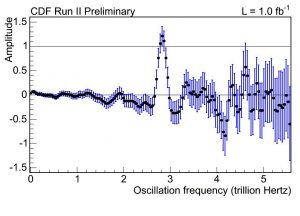
The figure shows the CDF measurement of the B_s oscillation frequency at 2.8 trillion times per second. The analysis is designed such that possible oscillation frequencies have an amplitude consistent with 1.0 while those not present in the data will have an amplitude consistent with zero. Image courtesy CDF collaboration.
Many experiments worldwide have worked to perform high precision measurements of the behavior of matter and antimatter, especially as it pertains to strange, charm and bottom quarks. Scientists hope that by assembling a large number of precise measurements involving the exotic behavior of these particles, they can begin to understand why they exist, how they interact with one another and what role they played in the development of the early universe. Most importantly, they could also be the place in which to look for new physics beyond the Standard Model, which scientists believe is incomplete. Although none of these particles exists in nature today, they were, however, present in great abundance in the early universe. Thus, scientists can only produce and study them at large particle accelerators.
With a talk at Fermilab on Friday, September 22, Christoph Paus of the Massachusetts Institute of Technology, representing the CDF experiment, presented the discovery to the scientific community. The experimenters acquired their data between February 2002 and January 2006, an operating period known as Tevatron Run 2, where tens of trillions of proton-antiproton collisions were produced at the world’s highest-energy particle accelerator. The results have been submitted in a paper to Physical Review Letters.
This first major discovery of Run 2 continues the tradition of particle physics discoveries at Fermilab, where the bottom (1977) and top (1995) quarks were discovered. Surprisingly, the bizarre behavior of the B_s (pronounced “B sub s”) mesons is actually predicted by the Standard Model of fundamental particles and forces. The discovery of this oscillatory behavior is thus another reinforcement of the Standard Model’s durability.
“Scientists have been pursuing this measurement for two decades, but the convergence of capabilities to make it possible has occurred just now,” said CDF cospokesperson Jacobo Konigsberg of the University of Florida. “We needed to produce sufficient quantities to be able to study these particles in detail. That condition was met by the superb performance of the Tevatron. Then, with a process this fast, we needed extremely precise detectors and sophisticated analysis tools. Those conditions were met at CDF, along with the skill and contributions of a great team of people.”
CDF physicists have previously measured the rate of the matter-antimatter transitions for the B_s meson, which consists of the heavy bottom quark bound by the strong nuclear interaction to a strange antiquark. Now they have achieved the standard for a discovery in the field of particle physics, where the probability for a false observation must be proven to be less than about 5 in 10 million (5/10,000,000). For CDF’s result the probability is even smaller, at 8 in 100 million (8/100,000,000).
“Everyone in Fermilab’s Accelerator Division has worked hard to create the number of collisions that were required to reach this impressive result,” said Fermilab Director Pier Oddone. “We’re glad that CDF has been able to put these efforts to such good effect. This is one of the signature measurements for Run II, and as we collect several times the data already on hand, I have great expectations for future discoveries.”
Determining the astonishing rate of 3 trillion oscillations per second required sophisticated analysis techniques. CDF cospokespersons Konigsberg and Fermilab’s Rob Roser explained that the B_s meson is a very short-lived particle. In order to understand its underlying characteristics, scientists have to observe how each particle decays to determine its true make-up.
“Developing the software tools to make maximal use of the information in each collision takes time and effort,” said Roser, “but the rewards are there in terms of discovery potential and increased level of precision.”
Many different theoretical models of how the universe works at a fundamental level will be now be confronted with the CDF discovery. The currently popular models of supersymmetry, for example, predict a much higher transition frequency than that observed by CDF, and those models will need to be reconsidered.
Marvin Goldberg, Division of Physics program director of the National Science Foundation, emphasized the collaborative role of the experimenters.
“This result reminds us that discoveries in particle physics require the coherent efforts of many people as well as advanced physical infrastructure,” Goldberg said. “By combining the luminosity of the Tevatron, the precision of the CDF detector and the intellectual prowess of the international CDF collaboration with sophisticated data analysis, this remarkable result from a remarkable effort will advance our understanding of the way the universe works.”
To further advance that understanding, Roser, Konigsberg and their colleagues continue to seek phenomena that are not predicted by the Standard Model. The prize would be a discovery of new physics.
“While the B_s oscillation discovery was one of the benchmark results that we wanted from the Tevatron,” said Roser, “we still have more than half the data from Run 2 waiting to be analyzed. We’re looking forward to more results, and we’re always hoping for surprises.”
CDF is an international experiment of 700 physicists from 61 institutions and 13 countries. It is supported by DOE, NSF and a number of international funding agencies (the full list can be found at http://www-cdf.fnal.gov/collaboration/Funding_Agencies.html). With the Tevatron, the world’s highest-energy particle accelerator, in 1995 the CDF and DZero collaborations discovered the top quark, the final and most massive quark in the Standard Model.
Fermilab is a Department of Energy Office of Science national laboratory operated under contract by Universities Research Association, Inc.
InterAction Collaboration media contacts:
- Fermilab, US: Mike Perricone, 630-840-3351, mikep@fnal.gov
- INFN, Italy: Barbara Gallavotti, + 39 06 6868162 (office), + 39 335 6606075 (cell phone), + 39 06 6868162 (fax), Barbara.Gallavotti@presid.infn.it
- High Energy Accelerator Research Organization (KEK), Japan: Youhei Morita, + 81 029 8796047, + 81 029 8796049 (fax), youhei.morita@kek.jp
- IN2P3-CNRS, France: Dominique Armand, + 33 01 44 96 47 51, darmand@admin.in2p3.fr
- Joint Institute for Nuclear Research, Dubna, Russia: Boris Starchenko, + 7 096 221 6 38 24, irinak@jinr.ru
- Particle Physics and Astronomy Research Council (PPARC), United Kingdom: Peter Barratt, + 44 (0) 1793 442025, + 44 (0) 787 602 899 (mobile), peter.barratt@pparc.ac.uk
- Lawrence Berkeley National Laboratory, California, USA: Ron Kolb, + 1 510 486 7586, rrkolb@lbl.govCDF institutions:
1. Academia Sinica, Taipei, Taiwan
2. Argonne National Laboratory, Argonne, Illinois
3. Institut de Fisica d’Altes Energies (IFAE-Barcelona), Spain
4. Baylor University, Waco, Texas
5. Brandeis University, Waltham, Massachusetts
6. University of California at Davis, Davis, CA
7. University of California at Los Angeles, Los Angeles, CA
8. University of California at San Diego, San Diego, CA
9. University of California at Santa Barbara, Santa Barbara, CA
10. Instituto de Fisica de Cantabria, CSIC-University of Cantabria, 39005 Santander, Spain
11. Carnegie Mellon University, Pittsburgh, PA
12. University of Chicago, Chicago, Illinois
13. Joint Institute for Nuclear Research, Dubna, Russia
14. Duke University, Durham, North Carolina
15. Fermi National Accelerator Laboratory (FNAL), Batavia, Illinois
16. University of Florida, Gainesville, Florida
17. University of Geneva, Switzerland
18. Glasgow University, United Kingdom
19. Harvard University, Cambridge, Massachusetts
20. University of Helsinki, Finland
21. University of Illinois, Urbana, Illinois
22. INFN, University of Bologna, Italy
23. INFN, Laboratori Nazionali di Frascati, Italy
24. INFN Sezione di Padova, Universita di Padova, Italy
25. INFN, University and Scuola Normale Superiore of Pisa, Italy
26. INFN, University di Roma I, Italy
27. INFN, Trieste, Italy, and Universita di Udine, Italy
28. IPP, Institute of Particle Physics, McGill University, Montréal, Canada
29. University of Toronto, Canada
30. ITEP, Institute for Theoretical and Experimental Physics, Moscow, Russia
31. The Johns Hopkins University, Baltimore, Maryland
32. Universitaet Karlsruhe, Germany
33. National Laboratory for High Energy Physics (KEK), Tsukuba, Japan
34. The Center for High Energy Physics(CHEP) Kyungpook National University, Seoul National University, and SungKyunKwan University, Korea
35. Lawrence Berkeley National Laboratory (LBNL) Berkeley, California
36. University of Liverpool, United Kingdom
37. University College London, United Kingdom
38. CIEMAT, Madrid, Spain
39. Massachusetts Institute of Technology (MIT), Cambridge, Massachusetts
40. Michigan State University, East Lansing, Michigan
41. University of Michigan, Ann Arbor, Michigan
42. University of New Mexico, Albuquerque, New Mexico
43. Northwestern University, Evanston, Illinois
44. The Ohio State University, Columbus, Ohio
45. Osaka City University, Japan
46. Okayama University, Japan
47. University of Oxford, United Kingdom
48. LPNHE and CNRS-IN2P3 – Paris, France
49. University of Pennsylvania, Philadelphia, Pennsylvania
50. University of Pittsburgh, Pittsburgh, Pennsylvania
51. Purdue University, West Lafayette, Indiana
52. University of Rochester, Rochester, New York
53. Rockefeller University, New York, New York
54. Rutgers University, Piscataway, New Jersey
55. Texas A&M University, College Station, Texas
56. Tufts University, Medford, Massachusetts
57. University of Tsukuba, Tsukuba, Japan
58. Waseda University Tokyo, Japan
59. Wayne State University, Detroit, Michigan
60. University of Wisconsin, Madison, Wisconsin
61. Yale University, New Haven, Connecticut
NSF and DOE Office of Science join forces to support community cyberinfrastructure with $30 million in awards to empower scientific collaboration and computation.
BATAVIA, Illinois – Scientists on the track to discovery got good news this month when a powerful computing tool received critical government funding. A five-year, $30 million award to the Open Science Grid Consortium, announced by the National Science Foundation and the U.S. Department of Energy’s Office of Science, will operate and expand the Open Science Grid, a computing environment used by scientists to harness computing resources and scientific data from around the world.
Fermilab will receive $1.1 million each year, or $5.5 million over five years, to contribute across many of the activities of the OSG. Besides OSG Executive Director Ruth Pordes, OSG security officer Don Petravick, Gene Oleynik for storage deployments, and Ian Fisk, head of US CMS user facilities, will lead the contributions to the OSG effort.
“The OSG is an important part of the Computing Division’s strategy in support of global computing for the Fermilab scientific communities,” said Fermilab Computing Division head Vicky White.
The OSG will also play a critical role with Fermilab hosting USCMS, the US component of the Compact Muon Solenoid experiment collaboration, when the Large Hadron Collider begins operations at CERN, the European Particle Physics Laboratory in Geneva, Switzerland in 2007.
“USCMS is pleased with this means to sustain the US distributed infrastructure from which we will extract our science,” said Fermilab’s Lothar Bauerdick, head of software and computing for USCMS. “The Fermilab USCMS community is also playing a leadership role in the OSG as a core piece of its worldwide data analysis system.”
Michael Strayer, Director of the Scientific Discovery through Advanced Computing program and Associate Director for Advanced Scientific Computing Research in DOE’s Office of Science, noted that the ability to reliably share and analyze petabytes of data is critical to scientific discovery.
“This investment in sustaining and extending the Open Science Grid is an important component of the petascale science infrastructure,” said Strayer.
The OSG is built and operated by a unique partnership of universities, national laboratories, scientific collaborations and software developers that work together to create a common distributed computing environment, or grid, for scientific research. Computing resources from more than 50 sites in the United States, Asia and South America are shared through the OSG. These resources range from small clusters of ten computers to large facilities with thousands of processors and millions of gigabytes of data storage.
“The OSG has been operating since 2005 and has already had an impact on several areas of scientific research, from particle physics to biology,” said Joseph Dehmer, director of the NSF’s Division of Physics. “The NSF has partnered with the DOE’s Office of Science in support of the OSG’s efforts to empower scientific communities by providing them with effective and dependable access to an unprecedented distributed computing facility.”
Fifteen members of the OSG Consortium, including eleven U.S. universities and four national laboratories, will receive funding through the OSG award. Over the next five years, the consortium will reach out to more scientists and scientific collaborations, helping them to harness the power of grid computing for their research.
“OSG Consortium members contribute to and benefit from the OSG, making it a true community cyberinfrastructure,” says Fermilab’s Pordes. “Our computing services support diverse research groups, and developers of campus and regional grids – points of entry to the grid for university scientists and students – are beginning to use the OSG environment to provide access to their resources.”
Scientists from many fields, including astrophysics, bioinformatics, computer science, nanotechnology, nuclear science and particle physics, use the OSG infrastructure. The LIGO Scientific Collaboration will use the OSG to integrate its computing facilities and enable its search for gravitational waves. Two particle physics collaborations rely on the OSG to fully participate in experiments at the Large Hadron Collider in Geneva, Switzerland.
“The U.S. particle physicists participating in the ATLAS and CMS experiments at the LHC will depend on the OSG to connect them with the data when it starts flowing from CERN in 2008,” said Robin Staffin, Associate Director for High Energy Physics in the DOE’s Office of Science. “Scientists will use LHC data to address profound questions about the universe, such as the origin of mass and the nature of dark matter.”
Together with other grid computing projects, from computing grids on university campuses to large national and international grid projects, the consortium works to create a worldwide computing infrastructure for scientific research.
“Distributed computing and cyberinfrastructure have the capability to transform research, but these tools and methods remain challenging for most scientists,” says Miron Livny from the University of Wisconsin-Madison, OSG Facility Coordinator. “Efforts such as the OSG work to democratize computing by lowering the barrier to individual scientists using distributed computing facilities.”
Funding for the OSG from the DOE’s Office of Science will be provided through the second round of the Scientific Discovery through Advanced Computing program. Funding support from the National Science Foundation is provided by the Mathematical and Physical Sciences Directorate, the Office of Cyberinfrastructure and the Office of International Science and Engineering.
For more information please visit http://www.opensciencegrid.org/
List of institutions that will receive funding through the OSG award:
Boston University
Brookhaven National Laboratory
California Institute of Technology
Columbia University
Cornell University
Fermi National Accelerator Laboratory
Indiana University
Lawrence Berkeley National Laboratory
Stanford Linear Accelerator Center
University of California, San Diego
University of Chicago / Argonne National Laboratory
University of Florida
University of Iowa
University of North Carolina/Renaissance Computing Institute
University of Wisconsin-Madison
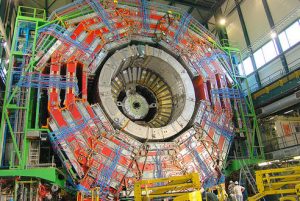
Through Fermilab, the US Department of Energy’s Office of Science has contributed $23 million to magnet construction for the Compact Muon Solenoid detector. Weighing in at more than 13,000 tons, the Compact Muon Solenoid experiment’s magnet is built around a 20-foot-diameter, nearly 43-foot-long superconducting solenoid – a wire coil with multiple loops, which generates a magnetic field when electricity passes through it. The CMS solenoid generates a magnetic field of 4 Tesla, some 100,000 times stronger than the Earth’s magnetic field. (Image courtesy USCMS.)
BATAVIA, Illinois – Scientists of the U.S. Department of Energy/Office of Science’s Fermi National Accelerator Laboratory and collaborators of the US/CMS project have joined colleagues from around the world in announcing that the world’s largest superconducting solenoid magnet has reached full field strength in tests at CERN, the European Particle Physics Laboratory.
Weighing in at more than 13,000 tons, the Compact Muon Solenoid experiment’s magnet is built around a 20-foot-diameter, nearly 43-foot-long superconducting solenoid – a wire coil with multiple loops, which generates a magnetic field when electricity passes through it. The CMS solenoid generates a magnetic field of 4 Tesla, some 100,000 times stronger than the Earth’s magnetic field, and stores 2.5 gigajoules of energy, enough to melt nearly 20 tons of gold. Superconductivity is achieved by chilling the coil to a temperature near absolute zero, where virtually all electrical resistance vanishes. Extremely high electrical current can then be used to generate a powerful magnetic field.
CMS is one of the experiments preparing to take data at CERN’s Large Hadron Collider (LHC) particle accelerator, scheduled to begin operations in November 2007. Physicists from the US, CERN and around the world will address some of nature’s most fundamental questions, such as why particles have mass, and what makes up the so-far-unexplored 96 percent of the universe. Through Fermilab, the DOE’s Office of Science has contributed $23 million to the CMS magnet construction.
“We see this excellent early test result as just the beginning of a great scientific return on our investment,” said Robin Staffin, DOE’s Associate Director, Office of High Energy Physics. “We see a strong and continuing U.S. role at the leading edge of particle physics research during an exciting new era of scientific discovery.”
Some 2000 scientists from 155 institutes in 36 countries – including approximately 600 members of US/CMS, the US contingent of the CMS collaboration – are working together to build the CMS particle detector, which is currently undergoing tests prior to installation in an experimental hall about 328 feet underground. The tests are being carried out with a full slice of the CMS detector, including all its subsystems.
“After recording 30 million tracks from cosmic ray particles,” said CMS spokesman Michel Della Negra of CERN, “all systems are working very well, and we’re looking forward to first collisions in the LHC next year.”
The CMS magnet has two unique characteristics: its strong magnetic field and the uniformity of its field over a large volume.
“This magnet is the central device around which the entire experiment is built,” said Fermilab’s Dan Green, Research Project Manager for US/CMS. “This test is a great success, and the entire process has gone very smoothly.”
The University of Wisconsin at Madison, a US/CMS member, designed the magnet’s steel return yoke for the detector endcap. Fermilab supplied the superconductor cable, along with aluminum matrix and stabilizing aluminum for the superconductor wire coil. The aluminum is needed to protect the coil against quenches by transporting heat away from the conductor. In addition, Fermilab engineered a strengthening of the cryostat supporting the hadron calorimeter, which tracks particle collisions and was also supplied by the US; and designed the magnetic field mapper, which offers detailed and accurate measurement of the field in three dimensions. The measurements are needed to confirm the design, and provide input to the tracking to accurately determine particle momenta. Green said the field mapper would be starting up soon.
CMS magnet construction was approved in 1996, and began in earnest in 1998. By 2002, fabrication of the superconducting wire was complete. Winding the cable to produce the solenoid coil began in 2000 and took five years to achieve. By the end of 2005, the solenoid was ready for testing, and in February this year, it was cooled down to its operating temperature of around -269 degrees Celsius. Following the insertion of particle detectors, testing started at the end of July.
The magnet is a common project in which all of CMS’s 155 institutes have taken part, with major contributions made by the Department of Energy’s Fermilab and the University of Wisconsin in US/CMS; the French Atomic Energy Commission in Saclay (CEA); CERN, the Swiss Federal Polytechnic Institute in Zurich (ETHZ); the Italian National Institute of Nuclear Physics (INFN) in Genoa, and the Russian Institute for Theoretical and Experimental Physics (ITEP) in Moscow.
Notes for Editors
CERN is the European Organization for Nuclear Research, with headquarters in Geneva, Switzerland. At present, its Member States are Austria, Belgium, Bulgaria, the Czech Republic, Denmark, Finland, France, Germany, Greece, Hungary, Italy, Netherlands, Norway, Poland, Portugal, Slovakia, Spain, Sweden, Switzerland and the United Kingdom. India, Israel, Japan, the Russian Federation, the United States of America, Turkey, the European Commission and UNESCO have Observer status.
Fermilab is a Department of Energy National Laboratory operated under a contract with DOE by Universities Research Association, Inc. Funding for U.S. participation in the LHC is provided by the Department of Energy’s Office of Science and the National Science Foundation.
US/CMS member institutions
(49 institutions, from 22 states and Puerto Rico)
California
California Institute of Technology, Pasadena (CMS)
Lawrence Livermore National Laboratory, Livermore (CMS)
University of California, Davis (CMS)
University of California, Los Angeles (CMS)
University of California, Riverside (CMS)
University of California, San Diego (CMS)
University of California, Santa Barbara (CMS)
Colorado
University of Colorado, Boulder
Connecticut
Fairfield University, Fairfield
Yale University, New Haven
Florida
Florida Institute of Technology, Melbourne
Florida International University, Miami
Florida State University, Tallahassee
University of Florida, Gainesville
Illinois
Fermi National Accelerator Laboratory, Batavia
Northwestern University, Evanston
University of Illinois at Chicago
Indiana
Purdue University, West Lafayette
Purdue University Calumet, Hammond
University of Notre Dame, Notre Dame
Iowa
Iowa State University, Ames
University of Iowa, Iowa City
Kansas
Kansas State University, Manhattan
University of Kansas, Lawrence
Maryland
Johns Hopkins University, Baltimore
University of Maryland, College Park
Massachusetts
Boston University, Boston
Massachusetts Institute of Technology, Cambridge
Northeastern University, Boston
Minnesota
University of Minnesota, Minneapolis
Mississippi
University of Mississippi, Oxford
Nebraska
University of Nebraska, Lincoln
New Jersey
Princeton University, Princeton
Rutgers State University of New Jersey, Piscataway
New York
Cornell University, Ithaca
Rockefeller University, New York
State University of New York at Buffalo
University of Rochester, Rochester
Ohio
Ohio State University, Columbus
Pennsylvania
Carnegie Mellon University, Pittsburgh
Puerto Rico
University of Puerto Rico, Mayaguez
Rhode Island
Brown University, Providence
Tennessee
Vanderbilt University, Nashville
Texas
Rice University, Houston
Texas A&M University, College Station
Texas Tech University, Lubbock
Virginia
University of Virginia, Charlottesville
Virginia Polytechnic Institute and State University, Blacksburg
Wisconsin
University of Wisconsin, Madison
Batavia, Ill.–Scientists at the Department of Energy’s Fermi National Accelerator Laboratory joined collaborators from around the world in announcing today (July 26) that the giant CMS detector at CERN, the European Organization for Nuclear Research, in Geneva, Switzerland, has been sealed and switched on to collect data for an important series of tests using cosmic ray particles. Cosmic rays from space provide a source of high-energy particles like those from accelerator-generated particle collisions.
U.S. physicists are among the CMS scientists taking and analyzing data from cosmic rays to calibrate and align the CMS particle detector in preparation for the start-up of the Large Hadron Collider accelerator at CERN next year. DOE’s Fermilab, near Chicago, Illinois, serves as the host laboratory for the U.S. CMS collaboration, and the U.S. helped to fund the design and construction of the detector.
“The U.S. Department of Energy is excited about what the LHC will bring to scientists’ understanding of the birth and present state of the universe,” said Dr. Robin Staffin, DOE associate director for High Energy Physics. “These results will surely be ‘historic events’!”
The LHC is a discovery machine, designed to answer fundamental questions about the universe. Four major experiments, ALICE, ATLAS, CMS and LHCb, will observe high-energy particle collisions produced by the LHC, looking for answers to questions such as what gives matter its mass, what the invisible 96 percent of the universe is made of, why nature prefers matter to antimatter and how matter evolved from the first instants of the universe’s existence. U.S. scientists collaborate on all four experiments.
“At the U.S. National Science Foundation, we are eagerly looking forward to the discoveries to be made at the LHC,” said Marvin Goldberg, program director in NSF’s Division of Physics. “Critical milestones like the cosmic challenge tell us that LHC startup is drawing near. Our anticipation is shared not only by particle physicists, but by school teachers, their students, and computer scientists. The LHC program is an example of what can be achieved by people at universities and laboratories of many nations working together cooperatively.”
The detector elements for the cosmic challenge, including two square meters of silicon, constitute an array larger than any used in CERN’s previous generation of experiments, but make up only about one percent of the final detector that will ultimately be installed in CMS when the LHC starts up.
“This is a major milestone in the progress toward the first data-taking in 2007,” said Fermilab physicist Dan Green, research program manager of the U.S. CMS collaboration. “It marks the end of the beginning. The detector is coming together as a fantastic instrument of discovery.”
Progress with the LHC accelerator itself passed an important milestone earlier this month, with installation of the main superconducting dipole magnets reaching the halfway mark, when the 616th dipole out of a total of 1232 was installed at 3 a.m. on July 12. The dipoles are the LHC’s key elements, and will steer the machine’s high-energy beams around their 27-km orbit.
-30-
Notes for Editors
CERN, the European Organization for Nuclear Research, is the world’s leading laboratory for particle physics. It has its headquarters in Geneva. At present, its Member States are Austria, Belgium, Bulgaria, the Czech Republic, Denmark, Finland, France, Germany, Greece, Hungary, Italy, Netherlands, Norway, Poland, Portugal, Slovakia, Spain, Sweden, Switzerland and the United Kingdom. India, Israel, Japan, the Russian Federation, the United States of America, Turkey, the European Commission and UNESCO have Observer status.
Fermilab is a Department of Energy National Laboratory operated under a contract with DOE by Universities Research Association, Inc. Funding for U.S. participation in the LHC is provided by the Department of Energy’s Office of Science and the National Science Foundation.
US Institutions Participating in LHC
88 institutions from across the United States participate in LHC experiments, and four US national laboratories belong to the LHC Accelerator Research Program (LARP). They are:
Arizona
University of Arizona, Tucson (ATLAS)
California
California Institute of Technology, Pasadena (CMS)
Lawrence Berkeley National Laboratory, Berkeley (ATLAS, LARP)
Lawrence Livermore National Laboratory, Livermore (CMS)
Stanford Linear Accelerator Center, Menlo Park (ATLAS, LARP)
University of California, Berkeley (ATLAS)
University of California, Davis (CMS)
University of California, Irvine (ATLAS)
University of California, Los Angeles (CMS)
University of California, Riverside (CMS)
University of California, San Diego (CMS)
University of California, Santa Barbara (CMS)
University of California, Santa Cruz (ATLAS)
Colorado
University of Colorado, Boulder (CMS)
Connecticut
Fairfield University, Fairfield (CMS)
Yale University, New Haven (ATLAS, CMS)
Florida
Florida Institute of Technology, Melbourne (CMS)
Florida International University, Miami (CMS)
Florida State University, Tallahassee (CMS)
University of Florida, Gainesville (CMS)
Illinois
Argonne National Laboratory, Argonne (ATLAS)
Fermi National Accelerator Laboratory, Batavia (CMS, LARP)
Northwestern University, Evanston (CMS)
University of Chicago, Chicago (ATLAS)
University of Illinois at Chicago (CMS)
University of Illinois at Urbana-Champaign (ATLAS)
Indiana
Indiana University, Bloomington (ATLAS)
Purdue University, West Lafayette (CMS)
Purdue University Calumet, Hammond (CMS)
University of Notre Dame, Notre Dame (CMS)
Iowa
Iowa State University, Ames (ATLAS, CMS)
University of Iowa, Iowa City (CMS)
Kansas
Kansas State University, Manhattan (CMS)
University of Kansas, Lawrence (CMS)
Maryland
Johns Hopkins University, Baltimore (CMS)
University of Maryland, College Park (CMS)
Massachusetts
Boston University, Boston (ATLAS, CMS)
Brandeis University, Waltham (ATLAS)
Harvard University, Cambridge (ATLAS)
Massachusetts Institute of Technology, Cambridge (ATLAS, CMS)
Northeastern University, Boston (CMS)
Tufts University, Medford (ATLAS)
University of Massachusetts, Amherst (ATLAS)
Michigan
Michigan State University, East Lansing (ATLAS)
University of Michigan, Ann Arbor (ATLAS)
Minnesota
University of Minnesota, Minneapolis (CMS)
Mississippi
University of Mississippi, Oxford (CMS)
Nebraska
Creighton University, Omaha (ALICE)
University of Nebraska, Lincoln (CMS)
New Jersey
Princeton University, Princeton (CMS)
Rutgers State University of New Jersey, Piscataway (CMS)
New Mexico
New Mexico University, Albuquerque (ATLAS)
New York
Brookhaven National Laboratory, Upton (ATLAS, LARP)
Columbia University, New York (ATLAS)
Cornell University, Ithaca (CMS)
New York University, New York (ATLAS)
Rockefeller University, New York (CMS)
State University of New York at Albany (ATLAS)
State University of New York at Buffalo (CMS)
State University of New York at Stony Brook (ATLAS)
Syracuse University, Syracuse (LHCb)
University of Rochester, Rochester (CMS)
North Carolina
Duke University, Durham (ATLAS)
Ohio
Case Western Reserve University, Cleveland (TOTEM)
Ohio State University, Columbus (ALICE, ATLAS, CMS)
Ohio Supercomputer Center, Columbus (ALICE)
Oklahoma
Oklahoma State University, Oklahoma (ATLAS)
University of Oklahoma, Oklahoma (ATLAS)
Oregon
University of Oregon, Eugene (ATLAS)
Pennsylvania
Carnegie Mellon University, Pittsburgh (CMS)
Penn State University, University Park (TOTEM)
University of Pennsylvania, Philadelphia (ATLAS)
University of Pittsburgh, Pittsburgh (ATLAS)
Puerto Rico
University of Puerto Rico, Mayaguez (CMS)
Rhode Island
Brown University, Providence (CMS)
Tennessee
Oak Ridge National Laboratory, Oak Ridge (ALICE)
Vanderbilt University, Nashville (CMS)
Texas
Rice University, Houston (CMS)
Southern Methodist University, Dallas (ATLAS)
Texas A&M University, College Station (CMS)
Texas Tech University, Lubbock (CMS)
University of Texas at Arlington (ATLAS)
Virginia
Hampton University, Hampton (ATLAS)
University of Virginia, Charlottesville (CMS)
Virginia Polytechnic Institute and State University, Blacksburg (CMS)
Washington
University of Washington, Seattle (ATLAS)
Wisconsin
University of Wisconsin, Madison (ATLAS, CMS)
BATAVIA, Illinois – “Citizen scientists” can take part in ecology research at the Department of Energy’s Fermi National Accelerator Laboratory beginning this month with the Prairie Quadrat Program, coordinated by the Fermilab Education Office. The Prairie Quadrat Program, which is free and open to the public, will teach participants how to map a prairie plot, identify prairie plants, and help Fermilab ecology experts track restoration progress.
“We are trying to restore the land back to its original condition before the pioneers,” said Mary Hawthorne of the Education Office. “This program will train ordinary citizens to help us.”
Participating “citizen scientists” may choose to document plants on their plot just once, or a few times per season; or they may “adopt” their plot and track its progress for years to come. Volunteers will enter their data into a website used by scientists to monitor the prairie’s condition. Quadrat participants will get to hike and explore parts of Fermilab’s preserve that are not normally open to the public.
“This is an excellent opportunity for people to share in Fermilab’s stewardship project,” said Fermilab Education Office Director Marge Bardeen.
Some of the free sessions will be geared toward groups of children and families, offering additional activities to keep children interested and occupied while parents “work their quad.”
There will be a total of 11 outings in May, June, July, and August. A complete schedule of outings and registration information can be found at http://www-ed.fnal.gov/data/life_sci/citizen/.
Fermilab is a national laboratory funded by the Office of Science of the U.S. Department of Energy, operated by Universities Research Association, Inc.
BATAVIA, Illinois – Summertime is a bright season of adventure and discovery for children, and now is the perfect time to add Science Adventures to your children’s schedule of discoveries for June, July and August at the Lederman Science Center at Fermilab, a U.S. Department of Energy lab.
Parents find adventures for Kindergarteners through seventh graders, with sessions lasting from a couple of hours to a full five-day week. Adventures are led by teachers from surrounding communities, members of Fermilab’s Education Office, and other professionals. Find a class that matches your child’s gifts and interests. A sampling, from June through July:
- Leonardo da Vinci, Grades K-4. Taste the life and times of a great artist, scientist and thinker. Design and build a catapult or flying machine…compose a picture using mathematical proportions…time travel to Italy in the 1400’s. (June 26-30, 12 PM to 2:00 PM, $95 per person)
- Good Vibrations, Grades K-3. Bang! Boom! Swish! Sound is all around us. Investigate the nature of sound. Create your own sound wave. Design musical instruments to make beautiful music. (July 15, 10:30 AM-11: 30 AM, $25 per person)
- Unlocking Science and Math Problems, Grades 2-5. Enjoy daily science experiments, games, puzzles and magic “tricks.” Young scientists investigate the Bernoulli effect, patterns in math and science, the magnetic force and so much more! This class is an exciting hands-on program for young scientists. (June 26-30, 9 AM to 11:00 AM, $95 per person)
- Lego Engineering Juniors, Grades 4-6. By popular demand, the Lego program is being expanded to younger grades, with a junior program on architectural engineering. We will build skyscrapers and check to see if they would withstand high winds and earthquakes. If time permits, we will also attempt a small mechanical engineering project. We encourage original designs. (June 24, 9:30 AM to 12:00 PM, $20 per person)
- Camp Invention, Grades 2-6. Crash-land on an alien planet in “Problem Solving on Planet ZAK,” build and test a new skateboard design with crash test dummies in “Spills and Chills,” design prototypes of roller coasters and other rides in “Imagination Point Ride Physics,” create a new problem-solving invention with recycled household items in “I Can Invent.”
To see the complete schedule and enroll in Science Adventures, go to the Fermilab Education Office’s home page on the Web (http://www-ed.fnal.gov). Then click on “Science Adventures.” Click on each adventure listing for a full description, times and fees, along with a registration form. For Camp Invention, you must register at http:www.campinvention.org, or call 330-849-8528.
This summer, the Education Office also offers “Hands-On Science for School Volunteers, Grades K-5.” Parent-Teacher Association volunteers can qualify to borrow a set of hands-on activities after attending this workshop! Free delivery, pickup and loan of a set of five exhibits that demonstrate the concepts of momentum and acceleration. Send a minimum of two representatives from your PTA for training (June 23, 9:30 AM-12:00 PM, $10 per person). Sign up at the “Science Adventures” home page.
Fermilab is a U.S. Department of Energy Office of Science national laboratory, operated under contract by Universities Research Association, Inc.
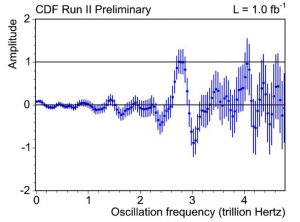
The figure shows the CDF measurement of the Bs oscillation frequency at 2.8 trillion times per second. The analysis is designed such that possible oscillation frequencies have an amplitude consistent with 1.0 while those not present in the data will have an amplitude consistent with zero. Image courtesy CDF collaboration.
BATAVIA, Illinois – Scientists of the CDF collaboration at the Department of Energy’s Fermi National Accelerator Laboratory announced today (April 11, 2006) the precision measurement of extremely rapid transitions between matter and antimatter. As amazing as it may seem, it has been known for 50 years that very special species of subatomic particles can make spontaneous transitions between matter and antimatter. In this exciting new result, CDF physicists measured the rate of the matter-antimatter transitions for the Bs (pronounced “B sub s”) meson, which consists of the heavy bottom quark bound by the strong nuclear interaction to a strange anti-quark, a staggering rate that challenges the imagination – 3 trillion times per second.
Dr. Raymond Orbach, Director of the DOE Office of Science, congratulated the CDF collaboration on “this important and fascinating new result” from the experiment.
“Exploration of the anti-world’s mysteries is a crucial step towards our understanding of the early universe, and how we came to be,” Orbach said. “Discoveries as important as oscillations to and from the antiworld have been made possible by the remarkable, record-breaking Run II luminosity of the Tevatron, a tribute to the skill of the Fermilab family. We look forward to continuing world leadership in high energy physics at this wonderful laboratory.”
Over the last 20 years, a large number of experiments worldwide have participated in a program to perform high precision measurements of the behavior of matter and antimatter, especially as it pertains to strange, charm and bottom quarks. The physics of particles containing bottom quarks is so exciting that two accelerator complexes, one in Stanford California and the other in Tsukuba Japan, were constructed to study these particles. Scientists hope that by assembling a large number of precise measurements involving the exotic behavior of these particles, they can begin to understand why they exist, how they interact with one another and what role they played in the development of the early universe. Although none of them exists in nature today, these particles were present in great abundance in the early universe. Scientists can only study them at large particle accelerators.
With a talk at Fermilab on Monday afternoon, the CDF collaboration presented to the scientific community the first measurement of this Bs matter-antimatter transition rate of about 3 trillion times per second, measured to a precision of 2 percent. They reported on data acquired by the CDF detector between February 2002 and January 2006, a running period known as “Tevatron Run II,” where tens of trillions of proton-antiproton collisions were produced at the Tevatron. There have been many attempts to measure this rate. The most recent result comes from the DØ collaboration (CDF’s sister experiment at the Tevatron) where they announced upper and lower bounds on the oscillation frequency (See the DØ announcement here).
The CDF and DØ results are compatible, although presented in different units. CDF reports the frequency of oscillation: the time period for a particle to become an anti particle and back again. DØ reports an angular frequency; equivalent to multiplying CDF’s result by a factor of 2pi (6.28). Therefore, CDF’s result of 3 trillion multiplied by 2pi gives a result of 18 trillion Hertz — consistent with DØ’s bounds of 17 and 21 trillion Hertz.
“If you think of matter and antimatter as performing a dance with each other, then we have measured the incredibly rapid tempo of that dance,” said CDF cospokesperson Jacobo Konigsberg. “The Tevatron physics program has offered the promise of making such a precision measurement, and it has delivered on that promise. The collaboration was intensely focused on mining this measurement away from Nature.”
Within the 700-member CDF collaboration, a team of 80 scientists from 27 institutions performed the data analysis leading to the precision measurement just one month after the data-taking was completed.
“After four years of intense effort with a spectacular team we spent some exciting weeks when we started to see the oscillation signal emerge from the data,” said analysis team leader Christoph Paus, professor at the Massachusetts Institute of Technology.
Experiment cospokesperson Rob Roser said the work was integrated within a relentlessly thorough confirmation process involving the entire CDF collaboration and all segments of the 4,000-ton collider detector.
“We’ve had many collaborators, each with a different background, examining this result from different angles,” Roser said. “They’ve worked through many sleepless nights, especially our graduate students and postdocs, to ensure that we have not overlooked something.”
Luciano Ristori, an Italian scientist and CDF collaborator with INFN in Pisa (National Institute for Nuclear Physics), is one of the primary architects of the novel electronics required to identify events with B mesons from the billions that collided. He looked upon this result with great pride.
“This is a very important result that required many years of hard work by a large number of very talented people,” Ristori said. “It is a great achievement that the CDF Collaboration and the Lab can be proud of.”
At Tsukuba University in Japan, CDF collaborator Prof. Shinhong Kim pointed to the future.
“This great result shows that the CDF experiment will continue to make important contributions to B physics study. This also gives a great example that international collaboration has been successful in high energy physics.”
Another CDF collaborator, Joseph Kroll, a professor at the University of Pennsylvania echoed his comments.
“Many of the upgrades to the CDF detector for Run II were aimed at increasing our sensitivity to observing Bs oscillations,” Kroll said. “Every collaborator contributed in some way to this measurement. It is very exciting to finally achieve this goal.”
Fermilab Director Pier Oddone cited the focus by accelerator and detector teams to achieve the new result.
“It is one of the signature measurements for Run II,” Oddone said. “As we collect several times the data already on hand, I have great expectations for future discoveries.”
Marvin Goldberg, Division of Physics program director, congratulated the collaboration.
“In the NSF Division of Physics, we call university groups our ‘Great Discovery Machine,'” Goldberg said. “These very important results from CDF required a remarkable synergy between the university groups and Fermilab, as well as major advances in all sectors of the Fermilab program.”
These sentiments are echoed by DØ cospokepeople Gerald Blazey and Terrence Wyatt.
“Bs mixing is an important result for the Tevatron, and we would like to congratulate CDF on this beautiful result,” they wrote. “The DØ result last month generated a great deal of excitement. This new result will generate further interest in Bs oscillations and demonstrates the vitality of the full Tevatron program.”
Within the high energy physics community, this CDF precision measurement will immediately be interpreted within different theoretical models of how the universe is assembled. One popular and well motivated theory is supersymmetry, in which each known particle has its own “super” partner particle. Fermilab theoretical physicist Marcela Carena noted that general versions of supersymmetry predict an even faster transition rate than was actually measured, so some of those theories can be ruled out based upon this result.
“At the Tevatron,” Carena said, “important information on the nature of supersymmetric models will be obtained from the combination of precise measurements of Bs matter-antimatter transitions and the search for the rare decay of Bs mesons into muon pairs. It is even possible that an indirect indication for supersymmetry would show up in these measurements before the Large Hadron Collider turns on at CERN.” Both DØ and CDF experiments expect to achieve improved results in these areas in the near future.
Scientists always hope for results that are surprising, and that contradict the conventional wisdom and predictions. The CDF scientists are no different. Their Bs precision measurement is squarely in accord with predictions of the Standard Model, but they view the agreement as another challenge in their quest for New Phenomena during Collider Run II of the Tevatron.
“It just means that Nature is tough on us as we try to learn its secrets,” said the outgoing CDF cospokesperson Young-Kee Kim, who will become Fermilab’s deputy director in July. “But we don’t give up, because we’re pretty tough, too. Although the standard model lives to fight another day, the broad physics program at the Tevatron still has many opportunities to open a window for new physics.”
CDF is an international experiment of 700 physicists from 61 institutions and 13 countries. It is supported by DOE, NSF and a number of international funding agencies (the full list of international funding agencies for the CDF experiment can be found at http://www-cdf.fnal.gov/collaboration/Funding_Agencies.html). With the Tevatron, the world’s highest-energy particle accelerator, in 1995 the CDF and DZero collaborations discovered the top quark, the final and most massive quark in the Standard Model.
Fermilab is a Department of Energy Office of Science national laboratory operated under contract by Universities Research Association, Inc.
CDF institutions:
1. Academia Sinica, Taipei, Taiwan
2. Argonne National Laboratory, Argonne, Illinois
3. Institut de Fisica d’Altes Energies (IFAE-Barcelona), Spain
4. Baylor University, Waco, Texas
5. Brandeis University, Waltham, Massachusetts
6. University of California at Davis, Davis, CA
7. University of California at Los Angeles, Los Angeles, CA
8. University of California at San Diego, San Diego, CA
9. University of California at Santa Barbara, Santa Barbara, CA
10. Instituto de Fisica de Cantabria, CSIC-University of Cantabria, 39005 Santander, Spain
11. Carnegie Mellon University, Pittsburgh, PA
12. University of Chicago, Chicago, Illinois
13. Joint Institute for Nuclear Research, Dubna, Russia
14. Duke University, Durham, North Carolina
15. Fermi National Accelerator Laboratory (FNAL), Batavia, Illinois
16. University of Florida, Gainesville, Florida
17. University of Geneva, Switzerland
18. Glasgow University, United Kingdom
19. Harvard University, Cambridge, Massachusetts
20. University of Helsinki, Finland
21. University of Illinois, Urbana, Illinois
22. INFN, University of Bologna, Italy
23. INFN, Laboratori Nazionali di Frascati, Italy
24. INFN Sezione di Padova, Universita di Padova, Italy
25. INFN, University and Scuola Normale Superiore of Pisa, Italy
26. INFN, University di Roma I, Italy
27. INFN, Trieste, Italy, and Universita di Udine, Italy
28. IPP, Institute of Particle Physics, McGill University, Montréal, Canada
29. University of Toronto, Canada
30. ITEP, Institute for Theoretical and Experimental Physics, Moscow, Russia
31. The Johns Hopkins University, Baltimore, Maryland
32. Universitaet Karlsruhe, Germany
33. National Laboratory for High Energy Physics (KEK), Tsukuba, Japan
34. The Center for High Energy Physics(CHEP) Kyungpook National University, Seoul National University, and SungKyunKwan University, Korea
35. Lawrence Berkeley National Laboratory (LBNL) Berkeley, California
36. University of Liverpool, United Kingdom
37. University College London, United Kingdom
38. CIEMAT, Madrid, Spain
39. Massachusetts Institute of Technology (MIT), Cambridge, Massachusetts
40. Michigan State University, East Lansing, Michigan
41. University of Michigan, Ann Arbor, Michigan
42. University of New Mexico, Albuquerque, New Mexico
43. Northwestern University, Evanston, Illinois
44. The Ohio State University, Columbus, Ohio
45. Osaka City University, Japan
46. Okayama University, Japan
47. University of Oxford, United Kingdom
48. LPNHE and CNRS-IN2P3 – Paris, France
49. University of Pennsylvania, Philadelphia, Pennsylvania
50. University of Pittsburgh, Pittsburgh, Pennsylvania
51. Purdue University, West Lafayette, Indiana
52. University of Rochester, Rochester, New York
53. Rockefeller University, New York, New York
54. Rutgers University, Piscataway, New Jersey
55. Texas A&M University, College Station, Texas
56. Tufts University, Medford, Massachusetts
57. University of Tsukuba, Tsukuba, Japan
58. Waseda University Tokyo, Japan
59. Wayne State University, Detroit, Michigan
60. University of Wisconsin, Madison, Wisconsin
61. Yale University, New Haven, Connecticut
The Department of Energy’s Fermi National Accelerator Laboratory invites buffalo fans to visit its herd of about 50 buffalo, including 7 young animals born since late March. Visitors may come to Fermilab’s Pine Street entrance and show a driver’s license to enter, then continue down pine road to the buffalo pasture to view the herd. Driving is restricted to selected roads leading to and from the buffalo pasture. Bicyclists currently are allowed access to the site without the need for a pass.
Everybody, especially families with small children, are welcome to come to the pasture where the young buffalo run around under the watchful eyes of “Mom and Dad Buffalo.”
Access is granted from 8 a.m. to 8 p.m., seven days a week. There is no fee. For up-to-date site access restrictions and other information call 630-840-3351 during business hours.
To learn more about Fermilab’s buffalo, please visit our Web site at www.fnal.gov/pub/about/campus/ecology/wildlife/bison.html.
Fermilab is a national laboratory funded by the Office of Science of the U.S. Department of Energy, operated by Universities Research Association, Inc.
